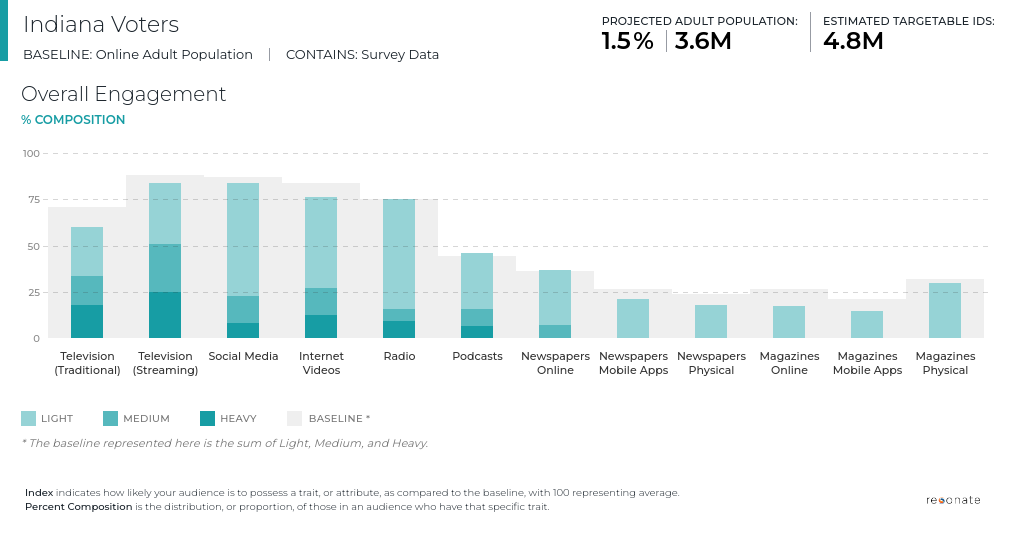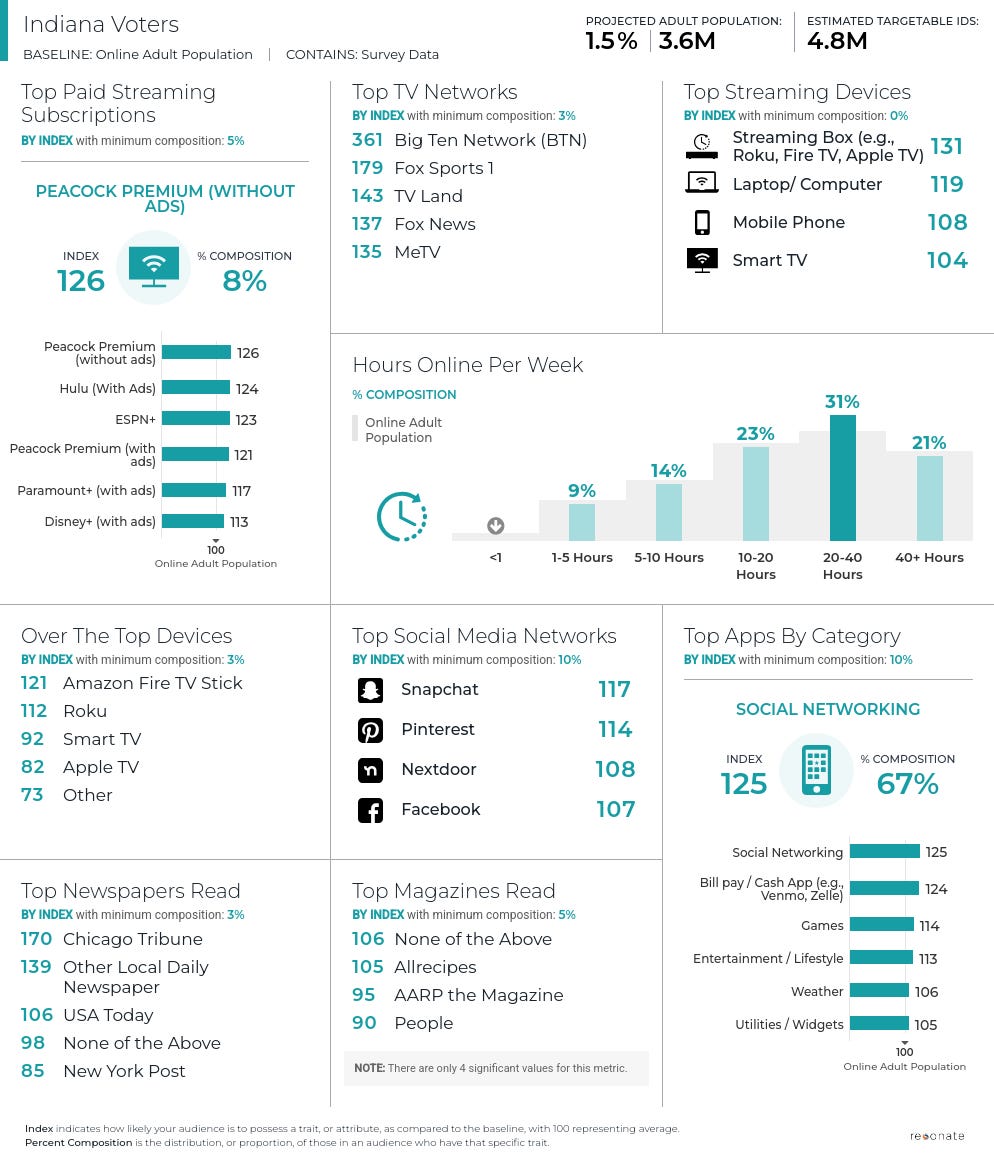RECAP: In the last issue we talked about “showing not tell” → Breaking Through the Noise: Rethinking Messaging in Today's Political Landscape”
What needs to remain in focus, as we look to combat Trump 2.0 and build political power for the democratic party —> how are we solving for voter apathy across Indiana and other “rigged” states.
Today - Let’s talk about Organic Reach - what it is, and why it is so important at the the local level.
Breaking Through the Noise
Getting a message heard in today’s crowded media landscape is tough. Effective messaging extends far beyond crafting a catchy slogan, selecting the perfect image, or using buzzworthy phrases to capture attention. It's equally about building and leveraging a robust infrastructure – an ecosystem that amplifies and delivers your message to your target audience, empowering them to take action.
This ecosystem encompasses various channels, platforms, and networks that work in tandem to disseminate your message, foster engagement, and drive meaningful impact. But the democrats have not been investing in this infrastructure, until recently. We can’t wait until the perfect ecosystem is built out - we must jump in and raise our voices now.
Our collective objective is clear…
- to raise awareness, mobilize, and vocalize the urgent threat posed by Trump and Co-President Elon Musk's destructive agenda. Their target list includes but limited to:
✅ Social Security
✅ Medicare
✅ Medicaid
✅ The Affordable Care Act
✅ Public Education
Additionally, the very foundations of our democratic institutions that have safeguarded our freedoms are being threaten. These pillars are not only crucial to our well-being but also the envy of the world. It is imperative that we unite and make our voices heard, exposing the dangers of their plans and protecting the progress we've made.
What do we know: a 360 overview
Digital Dominance: 86% of U.S. adults report getting news from digital devices at least sometimes, with 57% doing so often. Among digital platforms, news websites and apps are the most preferred sources, followed by social media and search engines
Television's Role: Despite the rise of digital media, 63% of Americans still get news from television at least sometimes, though only 33% do so often.
Decline of Traditional Media: Radio (NOT INDIANA) and print are far less popular, with only 26% of adults consuming news in print often or sometimes—the lowest recorded figures.
Generational Differences: Younger audiences (ages 18–34) prefer smartphones for news consumption, while older demographics lean more toward television.
Social Media's Impact: Over half (54%) of U.S. adults get news from social media platforms like Facebook and YouTube. TikTok has seen significant growth in regular news consumption among its users.
And thank you
➡️ “we need to also take into consideration the News-avoidant: or sometimes called passive news consumers, who were left behind by the traditional press years ago. This audience over-indexes as non-college educated, lower income, and lower propensity or non-voting Americans, and thus are not paying for paywalls, which means the pages of the New York Times, Wall Street Journal, and Washington Post, as well as most remaining local news publications, are inaccessible and irrelevant to their lives. Instead, they hear about what’s happening in Washington and elsewhere via their social media feeds, family, and friends. Maybe they’ll see a bit of news while scrolling on Instagram, or they’ll see their aunt or uncle comment on a piece of partisan clickbait on Facebook. For younger audiences, they may watch a popular non-political creator comment on the news in a video on TikTok.” ~ For the Record
How do we reach people? TO Show not Tell them what is happening. Start with organic reach - that is the number of people who see your content on social media through unpaid distribution – that is, without you spending money for your content to reach a specific audience. It is your friends, your family, your neighbors - your circle of influence. Why is this so important - the algorithm has been updated to prioritize personal connections.
Let's dive into how registered voters in Indiana are consuming media and getting their information. According to Resonate, here's a snapshot of their media habits this week.
Social media emerges as a key channel of engagement to reach Hoosiers, while radio remains a surprisingly resilient channel in the state, bucking national trends where it's on the decline.
Source: “Resonate Elements Data, 2024”
Now let’s take a closer look at each media channel across the state. Note - Due to 🏀 March Madness the “Top TV Networks” are a bit screwed this week. But this demonstrates media consumption fluctuates weekly and daily.
📱 Call outs under Social Media Networks.
➡️ Snapchat is leading the way this week.
➡️ Nextdoor 😳
How many candidates or local activities are we sharing on the app Nextdoor? It's worth noting that Amy Drake, an elected member of the St. Joseph County Council in Indiana, is already actively engaging with her constituents on Nextdoor and sharing her political views. And she is not holding back! As someone who also writes for the Federalist Society, Amy understands the value of being present and engaged across different spaces.
“Source: Resonate Elements Data, 2024”
Each district engages with media in unique ways. Compare Congressional District 2 with Congressional District 7.
Source: “Resonate Elements Data, 2024”
Source: “Resonate Elements Data, 2024”
Why this matters?
If you’re trying to advocate for change, understanding the system you are trying to navigate is important. Being active on social media matters. Facebook, Nextdoor, Snapchat, Instagram, LinkedIN - yes they are all important channels of communication.
Messaging on Social Media Needs to Be Person-Focused
Talking about democracy or institutions can feel abstract to many people. Instead, messages should focus on how political decisions directly impact individuals. Rather than saying, “We need to protect democracy,” it’s more effective to say, “This decision affects my job and my family” → backed by specific examples.
✅ Make it personal. People connect with real-life stories. Use concrete examples repeatedly - research shows that people need to hear the same message multiple times before it truly resonates.
✅ Sell the brownie, not the recipe. Instead of explaining policy details, highlight how policies impact everyday life. For example, rather than discussing healthcare legislation, share how changes in healthcare impact your family.
Personalizing messages helps people relate to issues, making them more likely to engage and take action. Real stories create empathy and understanding, driving meaningful conversations and change.
STOP DROP & GO
In today’s digital age, social media is a powerful tool for advocacy. And at the same time, it can be intimidating. If you opt not to share your personal stories but you would like to play a role combating disinformation is equally important. Try this quick and easy technique to engage with your audience while at the same time inserting facts into the conversation.
Spreading Facts in Online Discussions.
When you come across content that doesn't quite add up, take action.
🛑 STOP:
Google: Find a reputable source that supports your point of view.
📰 DROP:
Copy & Paste. Extract a key sentence or quote from the article that makes your point clear. Drop the Link. Share the full article in the chat for others to read.
🟢 GO:
Your goal isn't to change the original poster's mind, but to provide alternative perspectives and credible sources for those reading the comments. Resist the temptation to engage in debates - your mission is simply to drop in facts! By doing so, you'll help create a more informed online community, one fact at a time!
Final Thoughts - We need you to be active on social media, engaging with your community. The information echo chamber is vast, but breaking through starts at the local level.
Start thinking about how to make your messages more personal.
Get involved in local issues that matter to you.
Engage with your community to build connections and drive change.
📰 IN THE NEWS
📆 Mark your calendar for this Friday. If you live in a “rigged” state - that is us Indiana - and religion is working its way into the political conversation and GOP laws at the statehouse - I am sure you have questions. I know I did for sure. This is a conversation not to me missed! Matthew D. Taylor will talk about the Seven Mountain Mandate and why far-right American evangelicals have become so interested in controlling federal, state, and local government - this includes - Education!
➡️ ➡️ REGISTER HERE










Great article. I share aggressively on LinkedIn and Bluesky plus Substack. Too many bots to bother with Facebook. Nextdoor needs tolerance because you then need to deal with the endless stream of posts about porch thieves.
Every Democrat in Indiana should read this!